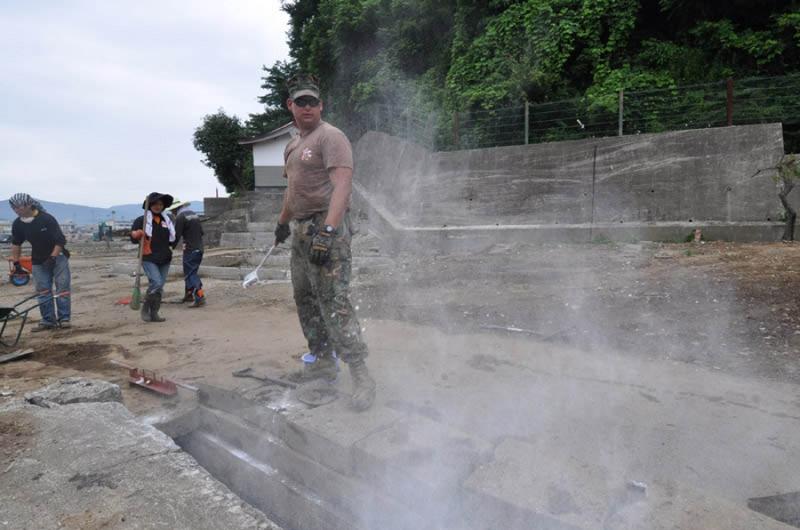

This website was created and maintained from May 2020 to May 2021 to commemorate the 75th anniversary of Stars and Stripes operations in the Pacific.
It will no longer be updated, but we encourage you to explore the site and view content we felt best illustrated Stars and Stripes' continued support of the Pacific theater since 1945.
Seabees still working in tsunami-ravaged northern Japan

Petty Officer 1st Class Joshua Thonnissen tosses a powder meant to help kill bacteria into a drainage ditch in Miyako, Japan, on Thursday. Thonnissen is one of three U.S. Navy Seabees currently working to help Japanese residents recover from a deadly tsunami that raced through the coastal city on March 11, following the massive earthquake that rattled the island nation.
By T.D Flack | Stars and Stripes July 16, 2011
MIYAKO, Japan — For the last nine weeks, a three-man team of Navy Seabees has labored along the northeastern Japanese coastline, helping local residents clean massive debris fields left when the March 11 earthquake and tsunamis devastated the area.
They work through long shifts of manual labor with two Navy front-end loaders and a dump truck and then sleep on Japanese tatami mat floors in a community center in Tanohata – about three hours south of Misawa Air Base. They carry their own food, barbecuing dinner each night, and they make do with baby wipes and a sink to clean themselves because the center doesn’t have shower facilities.
And even though temperatures are climbing, the Seabees – sweaty, dusty and dirty in their uniforms – said they’re loving every minute of it.
“It’s our bread and butter,” said Chief Billy Knox, leading chief petty officer of the public works department at the Naval Facilities Engineering Command Far East on Misawa.
Being away from family is never easy, but “They’re happy that we’re out there doing as much as we can helping” Japan with its recovery efforts, he said.
Knox and three of his Seabees — Petty Officer 1st Class Joshua Thonnissen, Petty Officer 1st Class Clifford Martin and Petty Officer 2nd Class Charles Hannah — spent the first six weeks after the earthquake working on the military fuel depot in nearby Hachinohe. But when the military mission there finished, they went looking to help.
The mayor of Tanohata — where base volunteers were working at the time — submitted a letter officially requesting the Navy’s help and heavy equipment, Knox said. Even as the U.S. military phased out of actively assisting Japanese recovery efforts via Operation Tomodachi, this small team has continued working.
Knox and his crew spent five weeks in Tanohata, working Monday through Friday and coming home to rest, recover and spend time with family each weekend. Military orders took Martin out of the country as they were finishing up with Tanohata, Knox said.
Now, it’s only three Seabees who work four days a week in Miyako, about four hours south of the base. The Tanohata officials – who they’ve developed a strong relationship with – allow them to stay in the community center so they only commute about an hour one-way each day.
The Seabees have been working in coordination with the Miyako volunteer center. Center officials tell them where they’re needed each day, pairing them up with volunteers who come from all over Japan.
On Thursday, they were working with a group of about 50 Japanese volunteers who had traveled to the area to help. The volunteers joked in Japanese about the strength of the Seabees, marveling at the ease in which they were able to manhandle heavily loaded wheelbarrows and toss sandbags filled with heavy sludge.
“We came from Nagano to help out,” said one man in Japanese, before asking what military ranks the Seabees were.
Communication can be difficult, Knox explained, but they do their best.
“Usually somebody speaks a little English,” said Thonnissen.
The Seabees said they’ve had countless encounters with local citizens who bring them snacks and cold drinks, bowing in thanks to the men in sweat-stained uniforms.
The Seabees think they’ll finish up at Miyako in about two weeks, and Knox isn’t sure if they’ll continue on in another community. He “hopes so,” but it depends on whether the communities ask for help.
Knox said he hopes that years from now, he’ll be able to look back and marvel at what a difference a few Seabees were able to make after the tsunami.
And he’s sure that the Japanese people they’ve met and worked with will think the same thing, that the Seabees “helped us out and did so much with so little.”


